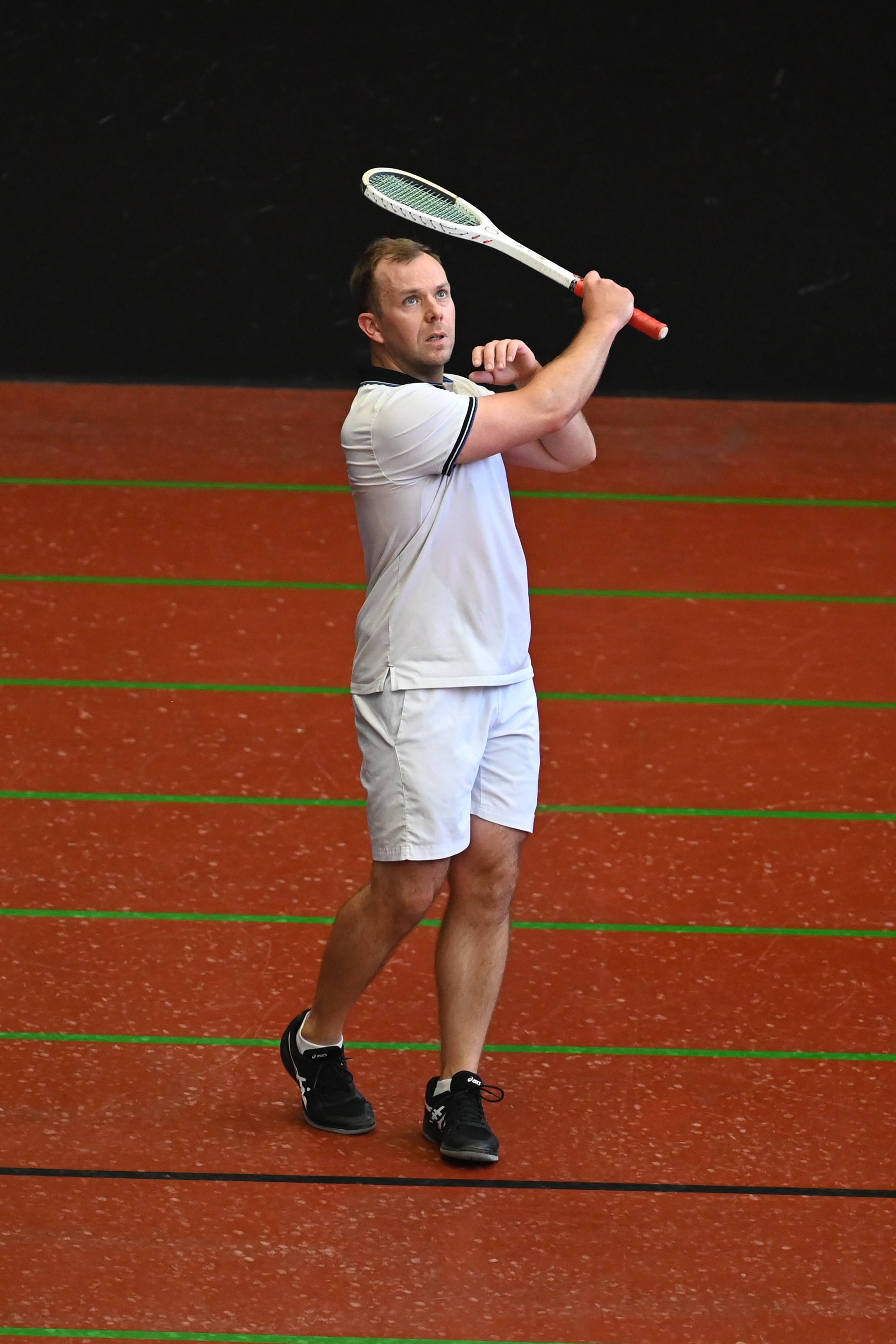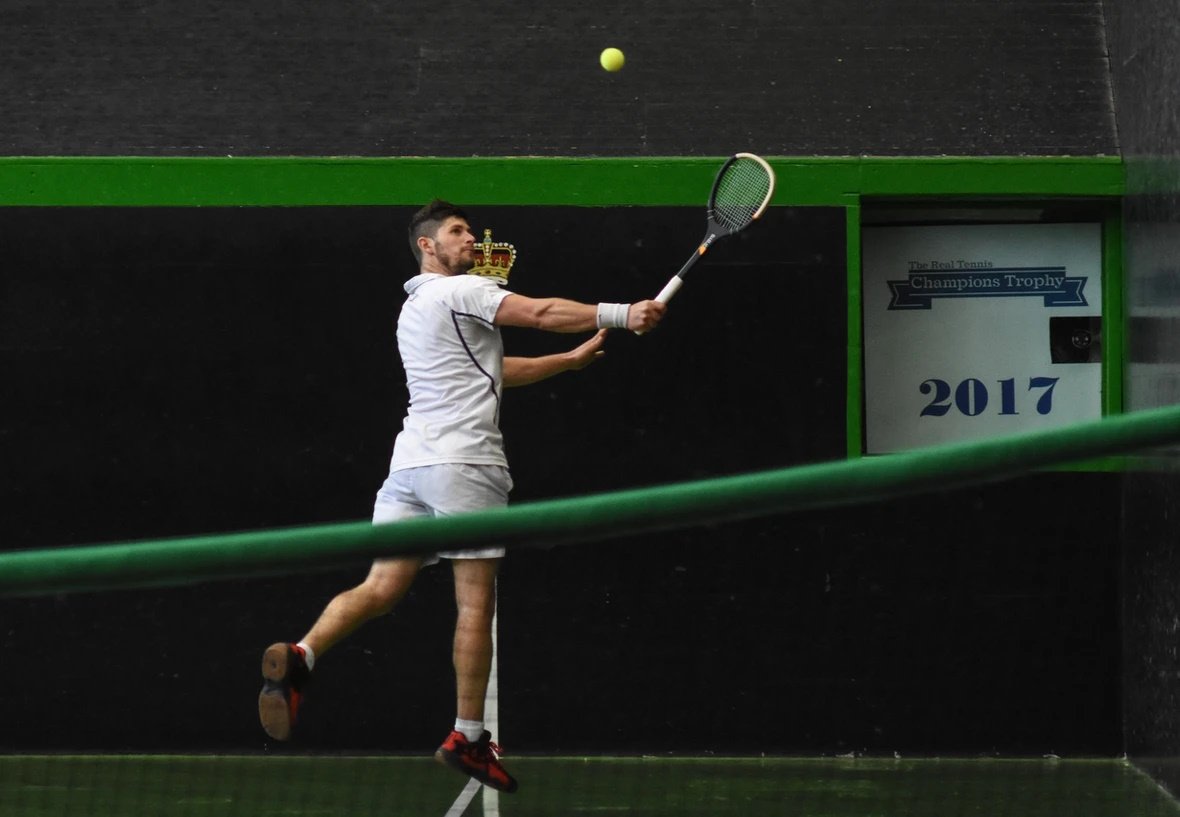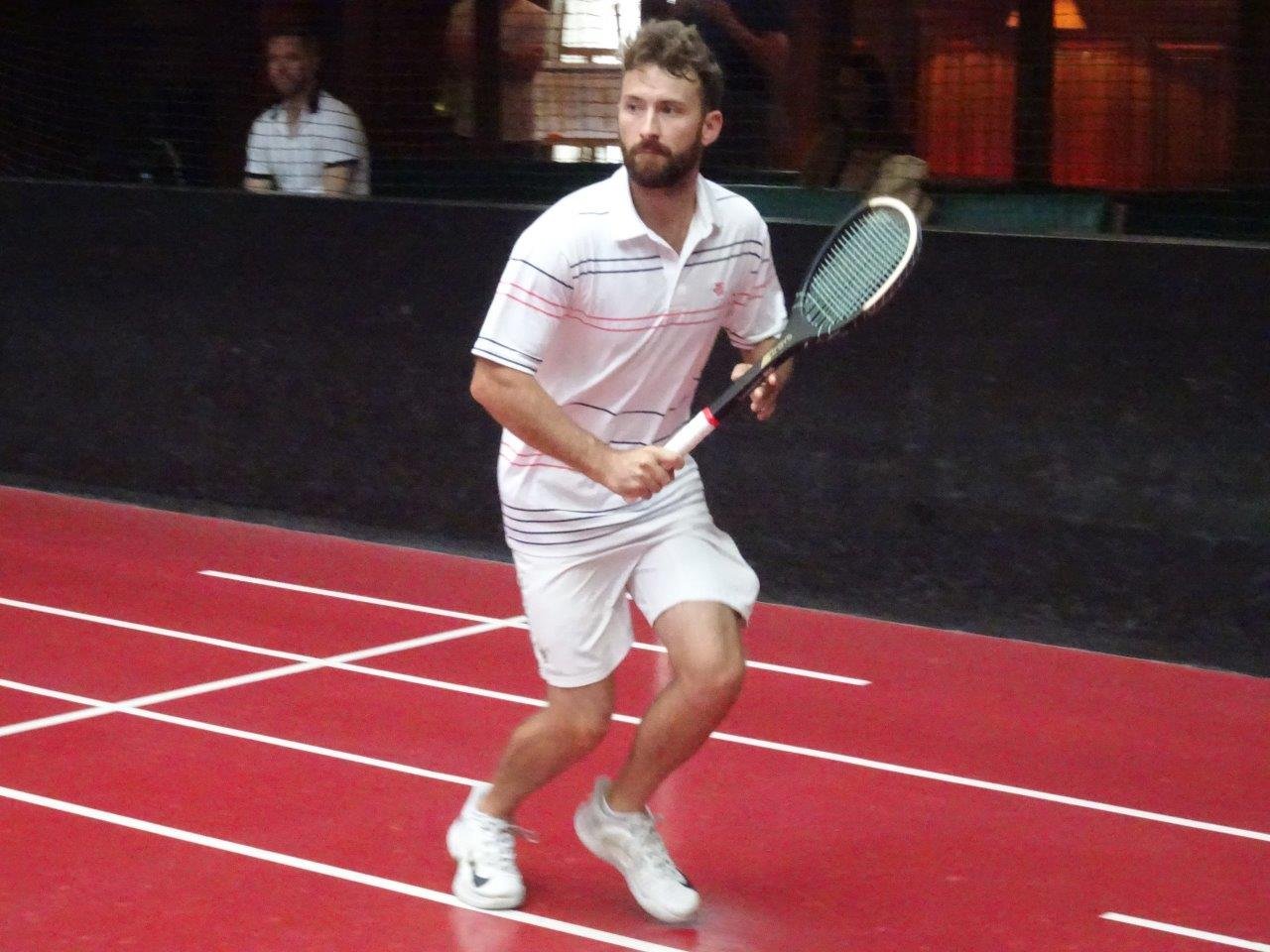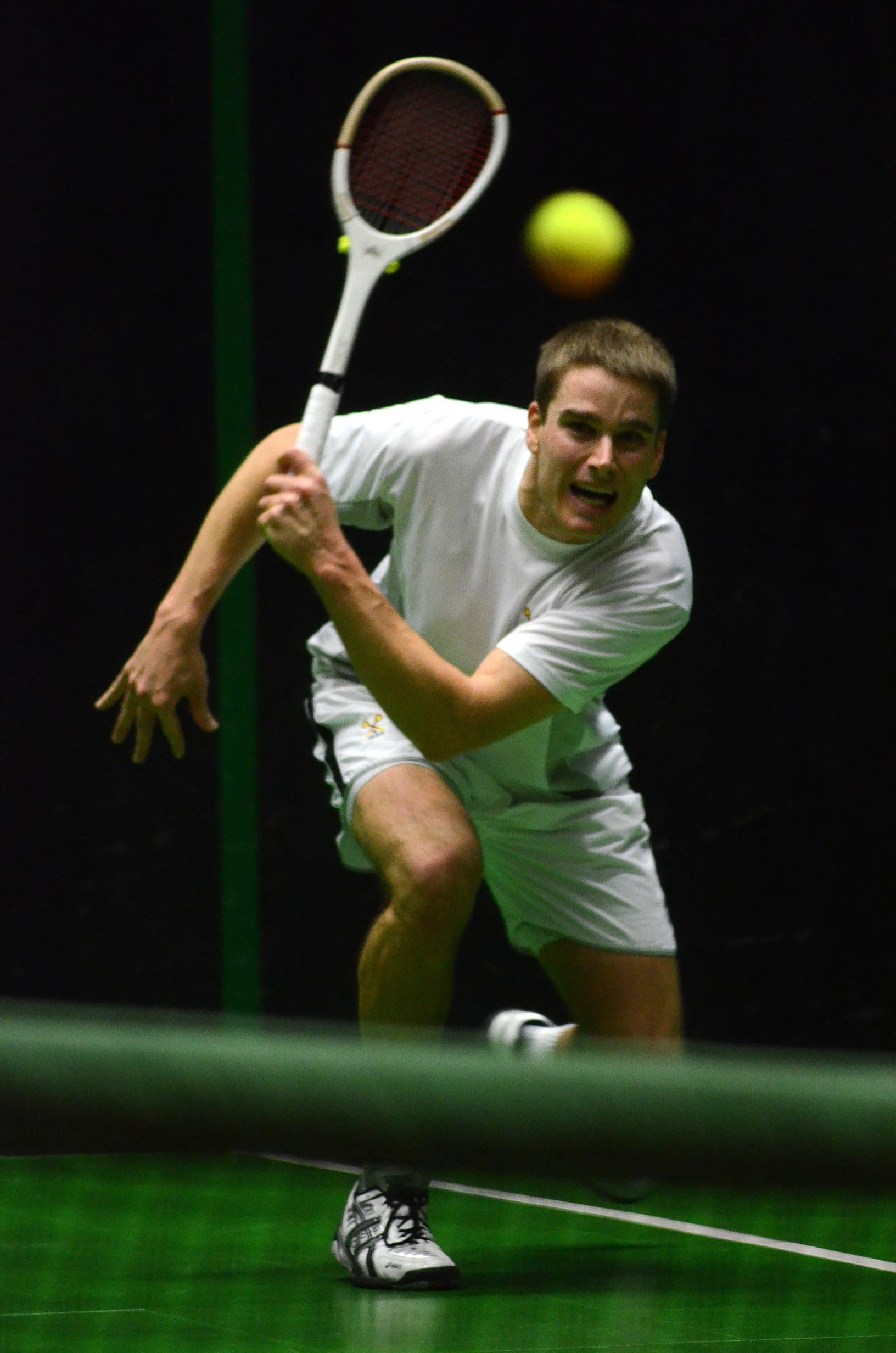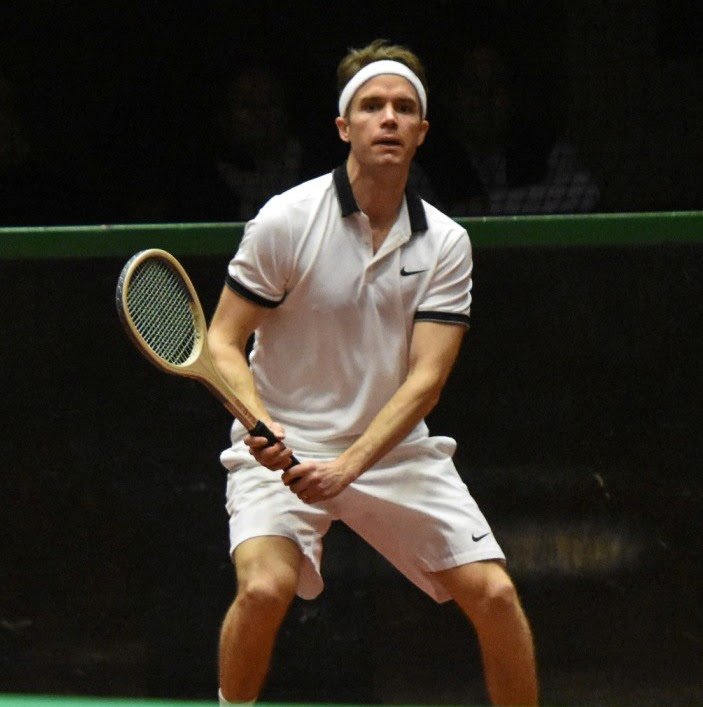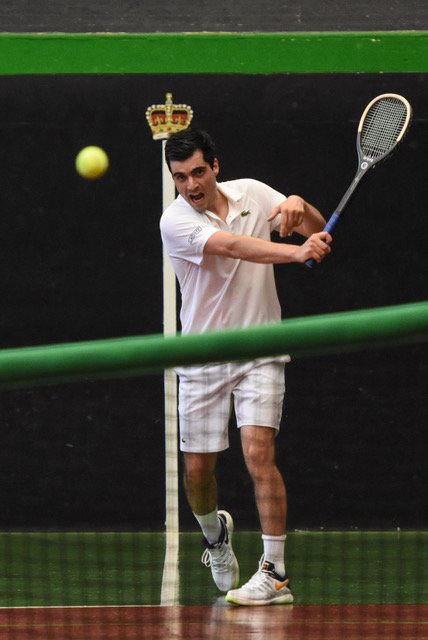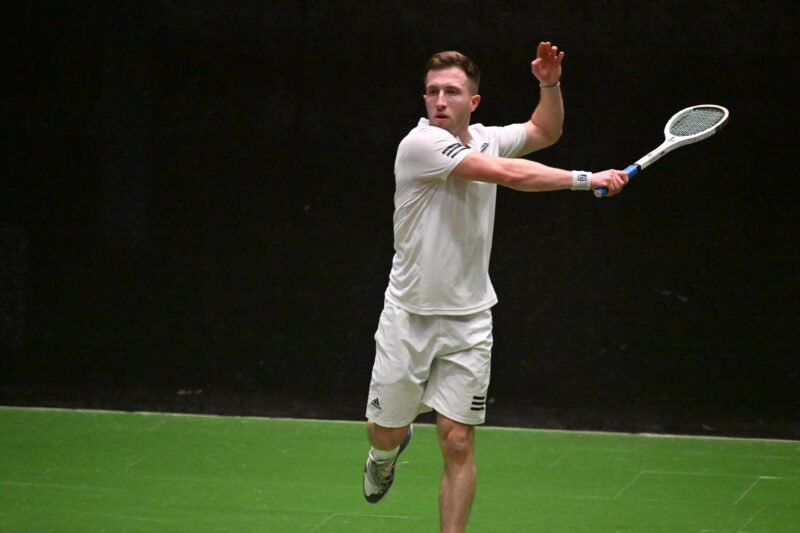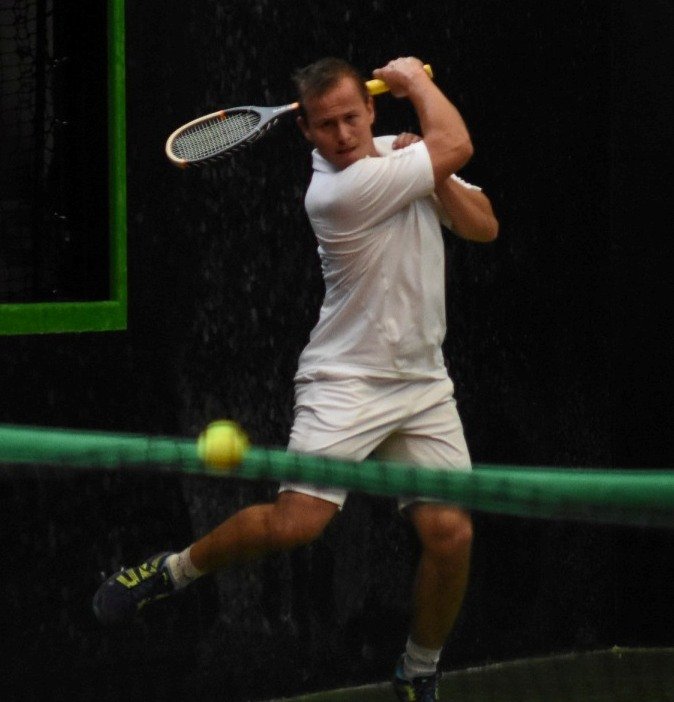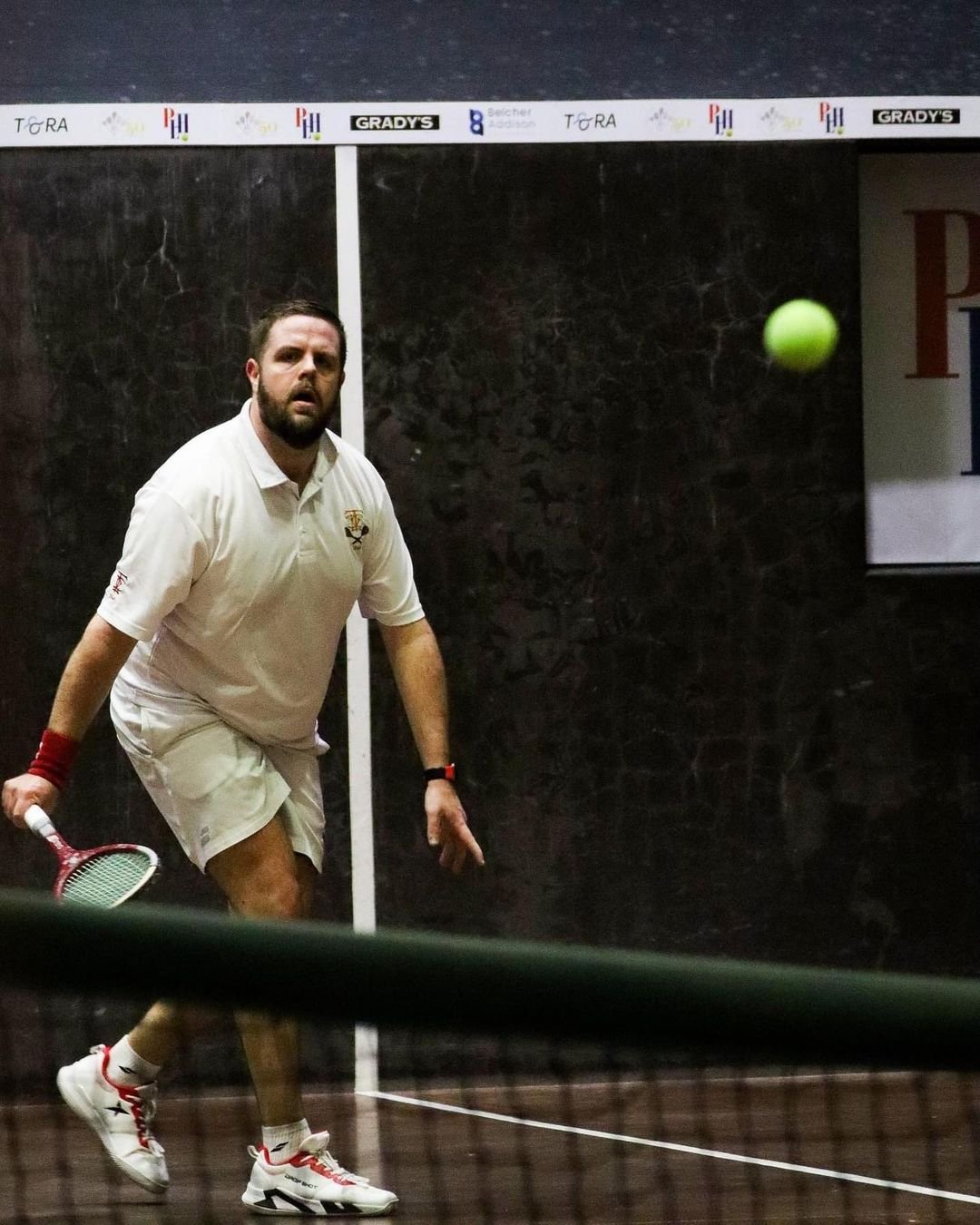PLAYERS
Qualification Group
Four of the ten Champions Trophy participants compete in a qualification group. The two players with the best results qualify for the main draw. Each match is one set to nine games. This event takes place over a single day, Tuesday 18th July, providing six quick-fire, high-pressure matches – exciting for both competitors and spectators.
The four qualifiers for 2023 are:
- Matthieu Sarlangue* (7th)
- Robert Shenkman* (8th)
- Darren Long (9th)
- Lewis Williams (10th)
* amateur
Qualification positions are determined by: number of wins; then games won/lost ratio, if tied; then the result between players, if tied.
All matches played on Tuesday 18th July
| Sarlangue | Shenkman | Long | Williams | Position | |
|---|---|---|---|---|---|
| Sarlangue | — | X | 9 | 9 | 2 |
| Shenkman | X | — | 9 | 9 | 1 |
| Long | 4 | 7 | — | X | 3 |
| Williams | 5 | 2 | X | — | 4 |
NB With the top two positions decided after the first four matches, and in light of injury concerns for Darren Long and Matthieu Sarlangue, the final two matches were cancelled.
Matthieu Sarlangue and Robert Shenkman joined the Main Draw, with Sarlangue drawn against Steve Virgona, and Shenkman facing Bryn Sayers.
Main Draw
Schedule
Monday 17th July: Practice Day
| Time | Players |
|---|---|
| 10:30 | John Lumley (1) & Bryn Sayers (6) |
| 12:30 | Leon Smart (4) & Lewis Williams (10) |
| 14:30 | Matthieu Sarlangue (7) & Robert Shenkman (8) |
| 16:30 | Ben Taylor-Matthews (2) & Steve Virgona (5) |
| 18:30 | Darren Long (9) & Nick Howell (3) |
Tuesday 18th July: Qualifying Rounds & Welcome Drinks
| Time | Players | Marker | Result |
|---|---|---|---|
| 11:00 | On court visitor experience | ||
| 11:30 | Sarlangue (7) vs Williams (10) | Scott Blaber | 9/5 |
| Followed by (approx 12:30) |
Shenkman (8) vs Long (9) | Jack Josephs | 9/7 |
| Break in play (approx 13:30) |
On court visitor experience | ||
| Followed by (approx 14:00) |
Sarlangue (7) vs Long (9) | Scott Blaber | 9/4 |
| Followed by (approx 15:00) |
Shenkman (8) vs Williams (10) | Jack Josephs | 9/2 |
| Break in play (approx 16:00) |
On court visitor experience | ||
| Followed by (approx 16:30) |
Long (9) vs Williams (10) | Scott Blaber | Cancelled |
| Followed by (approx 17:30) |
Shenkman (8) vs Sarlangue (7) | Jack Josephs | Cancelled |
NB With the top two positions decided after the first four matches, and in light of injury concerns for Darren Long and Matthieu Sarlangue, the final two matches were cancelled.
Matthieu Sarlangue and Robert Shenkman joined the Main Draw, with Sarlangue drawn against Steve Virgona, and Shenkman facing Bryn Sayers.
The Champions Trophy Welcome Drinks (invitation only) will be in the RTC Club Garden from 19:30 onwards.
Wednesday 19th July: Main Draw Day One
| Time | Match | Players | Marker | Result |
|---|---|---|---|---|
| 11:00 | On court visitor experience | |||
| 11:30 | A | Lumley (1) vs Howell (3) | Jack Josephs | 6/2 6/4 6/4 |
| Followed by | On court visitor experience | |||
| Followed by | B | Taylor-Matthews (2) vs Smart (4) | Scott Blaber | 6/2 6/1 6/1 |
| 16:30 | On court visitor experience | |||
| 17:00 | C | Virgona (5) vs Sarlangue (Q2) | Nick Wood | 6/3 6/4 6/0 |
| Followed by | On court visitor experience | |||
| Followed by | D | Sayers (6) vs Shenkman (Q1) | Jack Josephs | 5/6 6/5 6/3 6/3 |
Thursday 20th July: Main Draw Day Two
| Time | Match | Players | Marker | Result |
|---|---|---|---|---|
| 15:30 | On court visitor experience | |||
| 16:00 | E | Virgona (5) vs Howell (3) | Scott Blaber | 6/4 3/6 6/5 6/4 |
| Followed by | On court visitor experience | |||
| Followed by | F | Sayers (6) vs Smart (4) | Jack Josephs | 6/4 6/5 4/6 6/0 |
Friday 21st July: Rest Day
Saturday 22nd July: Semi-finals
| Time | Match | Players | Marker | Result |
|---|---|---|---|---|
| 10:30 | On court visitor experience | |||
| 11:00 | G | Lumley (1) vs Sayers (6) | Jack Josephs | 4/6 6/5 6/0 2/6 6/0 |
| Followed by | On court visitor experience | |||
| Followed by | H | Taylor-Matthews (2) vs Virgona (5) | Scott Blaber | 6/3 6/2 2/6 6/1 |
Sunday 23rd July: Final, Prize-giving & Party
| Time | Players | Marker | Result |
|---|---|---|---|
| 10:30 | On court visitor experience | ||
| 11:00 | Lumley (1) vs Taylor-Matthews (2) | Scott Blaber | 6/2 6/5 6/1 |
The Champions Trophy Prize Giving and Garden Party (ticket holders only) will be in the RTC Club Garden at 2pm.
How to Play
-
A player wins a point if
the ball travels over the net and is not returned
the opponent hits the ball out of court or into the net that divides the two halves of the court
the ball hits a Winning Target
the player wins the Chase in play
-
A player loses the rally if
the ball is not struck back to the opponents side of the court
the ball is struck into the net across the centre of the court, or out of court
the player is unsuccessful in beating a Chase
an illegal shot occurs, such as a double hit
-
It is possible for a rally to be inconclusive, ie where the point is not awarded to either player.
When this happens the score remains as it was before the start of the rally.
This happens when a Chase is laid, or, when playing off a Chase if the Chase if exacly matched/equalled (know as “Chase off”)
-
Players win points, in order to win games, in order to win sets, and ultimately, in order to win the match.
However, in addition to this there is an underlying battle of superiority over territory!
Statistically, the player at the Service End of the court wins a greater percentage of points, so players use Chases to wrestle their way to the Service End, and, when serving, attempt to prevent Chases so that they can remain there.
-
At the beginning of a match, the serving player is determined by a flip of a coin or, by the spin of a racket using the “rough or smooth” string on the racket (traditionally known as “trebling”). The player who wins the flip may choose to serve or receive.
Each rally begins with the Serve. The Serve is always delivered from the Service End of the court. The Serve must be delivered from any position behind the Service Line (also known as the Second Gallery line). The Serve is struck along the side penthouse and must have at least one true bounce on the penthouse on the Hazard (receivers) Side.
The ball must then land within the service box outlined at the receivers end of the court. The receiving player may choose to volley their return of serve, ie strike the ball before it hits the floor.
-
Lawn Tennis retains the same scoring system as Real Tennis. It is believed that this system is ancient and that it, in fact, predates the game itself. Based on the sexagesimal (base sixty) system, the scoring uses quarters of sixty, but with 40 replacing 45 at some time over the intervening centuries.
One subtle difference to the scoring compared to Lawn Tennis is that the player who won the point just completed has their score called first, whereas, in Lawn Tennis, the serving player’s score is always called first.
-
The Chase is one of the parts of Real Tennis that sets the game apart from other racquet sports. It’s not part of the scoring system; instead the Chase adds another layer of strategy and creates opportunities for the players to manipulate the asymmetric nature of the court to their advantage.
The strategic advantage lies with the player at the Service End of the court, though not due to the Serve itself (see above), but instead because there are more opportunities to win points outright when at that end.
To get to the Service End, a player must “lay” a Chase. It is the only way the players change ends. The players do not change at the end of a game or a set; they must earn the right to gain the Service End by laying a Chase.
-
A Chase is a measurement of the length of one players shot, requiring the opponent to attempt to improve upon it when the Chase is “played off” (after the players swap ends).
No point is scored by either player when a Chase is laid; it is a part-played point that will be completed at a later time.
The length of a Chase is determined by the distance from the back wall to the second bounce of the ball, using the Chase Lines that run across the floor of the court. Some Chase Lines are numbered whilst others are not. These are named after and associated with the netted Galleries down the side of the court (see court diagram).
A Chase can occur at both the Service End (a “Chase”) and at the Receiver’s End of the court (a “Hazard Chase”). They are named differently to remind players what is required when the Chase is being played off.
They can be set in one of two ways: if the ball bounces twice on the floor (measured where the second bounce lands in the Chase Area, the red floor at Hampton Court), or when the ball enters one of the netted Galleries along the side of the court.
The Galleries are separated by wooden posts that create the individual galleries, each with their own label: First Gallery (nearest the net that divides the court), The Door, Second Gallery and Last Gallery (nearest the back wall). Last Gallery at the Receiver’s End is called the Winning Gallery, and any shot from the Service End that goes into the Winning Gallery automatically wins the point for the server.
-
The second bounce on the floor always ends the rally. However, it is where the second bounce lands that determines the outcome.
The court floor is set out with areas where points are won - the Stroke Area (green at the Royal Tennis Court), and the Chase Area (red at the Royal Tennis Court) where chases are laid, won and lost.
A Chase is laid when the second bounce of the ball is determined to have landed in the Chase Area, or when the ball enters one of the side Galleries (apart from the Winning Gallery).
The second bounce is measured relative to the numbered or named lines on the floor (see diagram of the court). A point is not scored - although the rally is over - the outcome of the point has yet to be determined. The point, and therefore the outcome, will be concluded at a later stage within the game in progress, after the players change ends.
-
The only time that the players change ends is after a Chase is laid.
Players do not change ends at the end of games or sets. A Chase must be laid for player to gain the advantage at the Service End of the court.
The players change after two Chases have been laid, or, if one Chase has been laid and either player has reached game point - 40 or Advantage.
-
In the event of one Chase having been laid and game point, or two Chases having been laid, the players change ends.
The Chase or Chases that have been laid are now resolved - “played off”.
The player who did not lay the Chase now attempts to improve upon it, whilst the player that laid the chase attempts to defend it.
To improve on the Chase, the second bounce of the player’s shot must land closer to the back wall than that of the Chase being played off (or in a Gallery that is nearer to the back wall that that of the Chase being played off). If successful, the point is awarded to the player who has beaten the designated Chase. If unsuccessful, the point is awarded to the player defending the Chase.
To defend the Chase, the player must prevent the second bounce from landing closer to the back wall than the designated Chase (or entering a Gallery nearer to the back wall that that of the Chase being played off).
If the defending player is successful, and the ball crosses the net dividing the court, then the rally continues until resolved. The trick that the player defending the Chase can use is to deliberately allow the ball to bounce twice if they believe that the second bounce will result in the chase being lost.
If they are right, then they will win the point, but if they are wrong they will lose the point. Good awareness and judgement are required!
The defending player can also win a Chase by laying any Chase on the opposite side, eg using the Galleries. This tactic is widely used at the highest levels of the game, and so the player attacking the chase must also take this into account when choosing their shots.
-
The Grille
A rectangular window tucked in the back corner of the Receiver’s End of the court. Strike this to win the point outright.
The Winning Gallery
Located at the Receiver’s End of the court, this Gallery makes up part of the netted Galleries along the side of the court under the penthouse
To distinguish the Winning Gallery, there is a bell hanging to indicate a hit. Strike the Winning Gallery to win the point outright. And ring the bell!
Dedans
This wide rectangular netted Gallery is located at the very back of the Service End and is used as a viewing gallery for spectators. Strike the Dedans to win the point outright.
Winning “Zone” (green floor at the Royal Tennis Court)
Not strictly a “target” but an area on the floor at the Receiver’s End of the court only where a player can win an outright point. If a player hits a shot so that the second bounce of the ball lands in this area then they win the point.
The Chase “Zone” (red floor at the Royal Tennis Court)
Other than the Winning Zone, the rest of the floor area is where Chases are laid and played off.
Event Information
Getting to Hampton Court Palace
See the RTC Home page for address and telephone numbers, and the HCP Getting Here page for directions and more general Palace information.
Parking
Visitors can use the main public car park within HCP if there is space. The entrance is via the main gate immediately on the north side of Hampton Court Bridge. If the main gate is shut then you can drive up to it and the security guards will open it and let you in if you tell them that you are visiting to watch the Champions Trophy tennis.
If the car park is full then you will have to use one of the public car parks at Hampton Court station or in Bushy Park, or find a space in the limited on-street parking nearby.
Getting to the court
Entrance is via Tennis Court Lane the road that runs along the left hand side of the Palace when viewed from the main, front entrance.
Go through the security barrier, where the guards will have your name on a list. Continue to the very end of the lane and go through the left hand archway facing you. Go through two sets of doors and you will arrive at the court. The club rooms are at the far end of the court, behind the dedans.
Tourists and other visitors to HCP are free to watch from behind the hazard and service galleries during British Summer Time.




